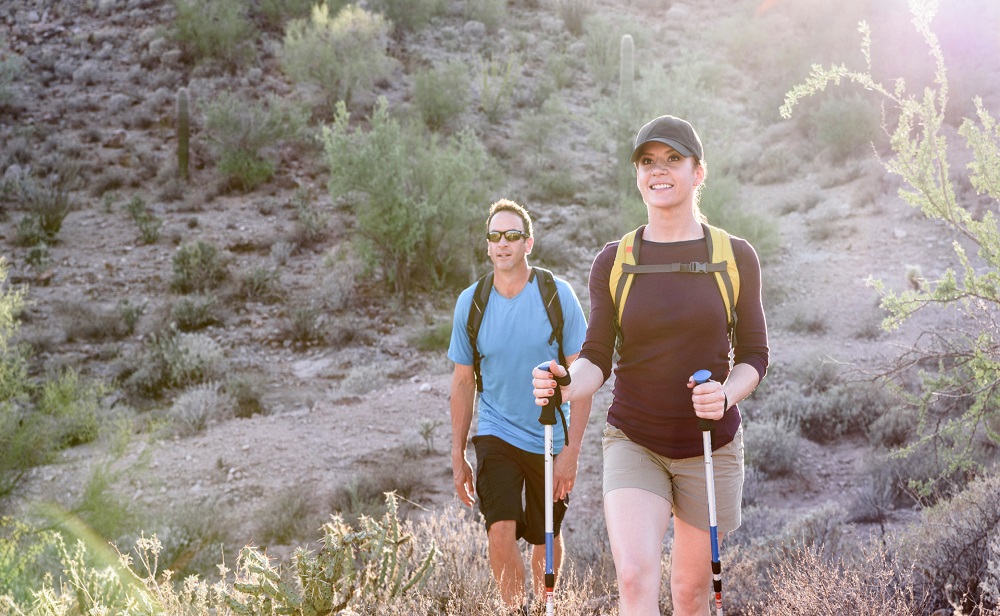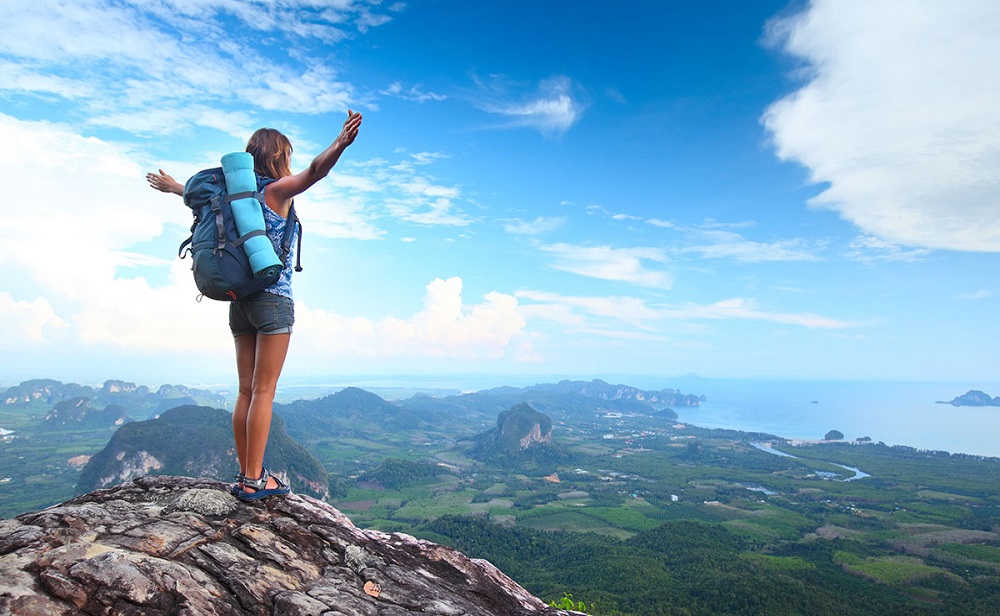What To Wear Hiking In Hot Weather

Hiking is a great way to get some exercise and enjoy nature. But it can also be quite uncomfortable if you don’t dress appropriately. The temperature outside can affect your body temperature, causing heatstroke or hypothermia. Many people hike wearing shorts and t-shirts when choosing what to wear hiking in hot weather, but that doesn’t always work well when the temperatures are high.
You need to make sure you have clothing that will keep you comfortable while protecting you from the sun. Here are some things to consider before heading out on the trail.
WHAT TO WEAR HIKING IN HOT WEATHER
1. Sunscreen
When considering what to wear hiking in hot weather, Sunscreen is important for preventing skin cancer and other health problems caused by ultraviolet (UV) rays. It protects your skin from burning and prevents premature aging of your skin. Make sure you use sunscreen with an SPF rating of at least 30. If you plan to spend time outdoors during midday hours, apply sunscreen every two hours.
2. Hats
A hat keeps the sun off your head and neck. Wear one even if you’re not going to be spending much time outdoors. This helps prevent sunburns and reduces the risk of developing skin cancers. A wide brimmed hat works best because it covers more area than a baseball cap.
3. Sunglasses
Sunglasses protect your eyes from UV rays. Choose sunglasses that offer 100% UVA protection. You want to avoid lenses made of plastic, which may degrade over time. Look for frames made of polycarbonate material instead. These lenses won’t yellow or crack like those made of acrylic. They’ll also provide better visibility.
4. Sweatpants
Sweatpants help keep you cool and dry. They absorb sweat away from your skin so you stay cooler. Look for pants made of cotton or nylon fabric. Avoid synthetic fabrics such as spandex, which can trap moisture against your skin.
5. Waterproof Clothing
Waterproof clothing is essential for hiking in hot weather. When hiking in hot weather, you’ll likely encounter water sources along the trail. Wearing waterproof clothing will keep you dry.
6. Long Sleeve Shirt
Long sleeve shirts are recommended for hiking in hot weather because they cover most of your arms and chest. They also allow air to circulate around your body, keeping you cool.
7. Lightweight Jacket
If the temperature is expected to reach 90 degrees Fahrenheit or higher, you’ll need a lightweight jacket. Look for jackets made of breathable materials such as nylon or polyester. Avoid synthetics such as spandex or acrylic.
8. Walking Shoes
What to wear hiking in hot weather is not complete without your favorite pair of walking shoes. Walking shoes should be comfortable enough to walk long distances in them. They should fit properly and feel sturdy. Look for shoes that support your feet and ankles. They should also be designed to wick away moisture.
9. Footwear Protector
Footwear protectors come in handy when hiking through muddy areas. They’re designed to keep mud from getting inside your shoe. Simply place your foot into the protector, then pull up the sides until it fits snugly around your entire foot.
10. Tie
Ties keep your clothes secure and free from wrinkles. Many hikers prefer a tie since it provides extra security. However, ties aren’t necessary if you have a backpack on.
11. Backpack
Backpacks make carrying gear easier and more convenient. Although backpacks are bulky, they’re useful for storing food and other items needed while hiking.
12. Food
Hiking requires energy. Eating before leaving home will give you the strength you need to hike well. Pack a snack and drink that you enjoy. Avoid eating too many high-calorie foods, though. You don’t want to end up feeling bloated while hiking.
13. First Aid Kit
When choosing what to wear hiking in hot weather, remember to pack a first aid kit. In addition to bandages, antiseptic wipes, and pain relievers, include items such as sunscreen lotion, insect repellent, lip balm, and antihistamines. Doing this will ensure you stay safe and healthy while hiking.
14. Insect Repellant
Insect bites and stings can cause discomfort and itching. To reduce the chances of being bitten by insects, use an insect repellent. Look for products with DEET, picaridin, oil of lemon eucalyptus, or IR3535. Apply these products to exposed areas of your skin including your face, hands, legs, and torso. Don’t apply any product directly onto your lips or mouth.
15. Sunscreen Lotion
Sunburns are common among people who spend time outdoors. To prevent sunburns, apply sunscreen lotion before heading out. Choose a broad spectrum SPF 30+ sunscreen with at least UVA protection. Apply the lotion liberally over your exposed skin.
16. Water Bottle
You need to carry drinking water when contemplating on what to wear hiking in hot weather . A water bottle makes it easy to access water while on the go. Select one that’s large enough to hold several cups of water. If you plan to hike for several hours, choose a larger bottle so you won’t have to stop frequently to refill your water bottle.
17. Headlamp
A headlamp helps illuminate dark places like caves and forests. It’s important to know how to operate a headlamp. For example, turn it on using the switch located on the side of the lamp. Once switched on, rotate the headband to adjust the brightness.
18. Compass
A compass is essential for orienting yourself when hiking. Carry a compass that has a clear plastic housing. This type of compass features a liquid crystal display (LCD) screen that allows you to see the direction of north. Additionally, some compasses feature magnetic needle indicators. These allow you to determine whether you’re facing east or west.
19. Map
Maps help you navigate unfamiliar terrain. Hikers often rely on maps to find their way. Make sure you carry a map that shows the area where you intend to travel.
Hiking Outfit For Women

Women should consider wearing hiking clothes that provide comfort and ease of movement. The following list includes clothing suggestions for women who plan to hike during warm weather. This means selecting tops and bottoms that are lightweight and breathable. Below are additional tips for dressing for hiking in hot weather for women.
1. Loose Clothing
Loose clothing provides freedom of movement. When selecting hiking clothes for women, look for loose shirts and pants. They should be made from breathable fabrics that wick moisture away from your body.
2. Tops
The best tops for women hiking are those that fit properly. When selecting a top, consider its size. Smaller tops tend to be better suited for hiking than bigger ones. Also, look for a material that wicks moisture away from your body. Cotton is a good choice because it dries quickly.
3. Bottoms
The best bottoms for women hiking are those made of breathable materials. Breathability refers to the ability of fabric to let air pass through it. Some pants are designed to keep hikers cool by allowing perspiration to evaporate. Others are designed to keep hikers warm by trapping heat inside them.
4. Shoes
Women should select shoes that provide support. Support comes in two forms—ankle support and arch support. Ankle supports are usually found in hiking boots. Arch supports are typically found in running shoes. Both types of supports are necessary for comfortable hiking.
4. Socks
Socks protect feet against blisters and other injuries. They also add warmth to cold environments. When selecting socks, look for a pair that fits comfortably. Avoid thick socks because they may restrict blood flow.
5. Gloves
Gloves can protect hands from the elements. Look for gloves that offer maximum dexterity and comfort. You want to avoid gloves that feel too tight around your wrists.
Rules for Hiking in Hot Weather
In addition to choosing appropriate clothing, there are several rules that apply to hiking in hot weather. Here are three things to remember when hiking in hot weather.
1. Start Early
Starting early will reduce the amount of time spent hiking in hot weather. It also gives you more time to acclimate to the environment. If you start hiking at noon, you’ll have less than an hour to adjust to the temperature before heading out.
2. Drink Plenty of Water
Drinking water is an absolute necessity when hiking in hot weather because dehydration occurs at a much faster rate. Dehydration causes fatigue, muscle cramps, headaches, nausea, dizziness, and thirst. As a result, hikers must drink plenty of fluids before, during, and after hikes.
3. Salty Foods
When hiking in hot weather, salty foods such as potato chips or pretzels help prevent dehydration. These snacks contain sodium which helps regulate fluid levels in the body. Salt also reduces sweating.
4. Beware Of Heat Stroke
Heat stroke occurs when the body overheats. Symptoms include headache, weakness, confusion, rapid heartbeat, and lack of coordination. In severe cases, heat stroke can lead to death. To prevent heat stroke, stay hydrated and take frequent breaks.
5. Don’t Forget To Rest
Hikers should always rest when tired. This includes resting between hikes. The reason is simple—resting allows muscles to recover and prevents injury.
6. Check The Weather
Checking the weather before hiking will give you a sense of how hot it might be. A thermometer placed on the ground near where you plan to hike will tell you if the temperatures are rising. Sometimes, even this information isn’t enough to prepare you for the conditions ahead. So, check the forecast often.
7. Picking The Right Trail Is Important
Choosing the right trail is important. Trails with shade trees provide relief from the sun. Trails with lots of vegetation provide protection from the wind. And trails without obstacles present fewer challenges. Knowing these factors will help you choose the best trail for your needs.
8. Carry Appropriate Gear
Carrying gear that matches the terrain you intend to hike in is essential. For example, if you intend to hike in desert-like conditions, you need to carry clothes that resist moisture. Also, make sure you carry extra food and water.
9. Know Your Limit
Knowing your limits is another way to ensure safety while hiking in hot weather. When hiking in hot weather, hikers should limit their activities to those they know they can complete safely.
10. Avoid Alcohol
Alcohol makes people sweat more. This means that drinking alcohol while hiking in hot weather could increase your risk of getting sick. This is especially true if you don’t drink enough water.
Conclusion
If you want to enjoy hiking in hot weather, then you need to do some planning beforehand. By following our tips, you’ll avoid many common problems associated with hiking in hot weather.
The most important thing to remember about hiking in hot weather is that it’s not all bad. Hiking in hot weather has its benefits. However, there are several things you should keep in mind such as what to wear hiking, so you don’t end up suffering from heat exhaustion or worse.